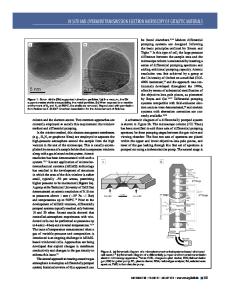Indentation mechanics of Cu-Be quantified by an in situ transmission electron microscopy mechanical probe
- PDF / 1,464,005 Bytes
- 7 Pages / 612 x 792 pts (letter) Page_size
- 74 Downloads / 344 Views
J.B. Pethica Department of Materials, University of Oxford, Oxford, OX1 3PH United Kingdom; and Physics Department, Trinity College, Dublin 2, Ireland
B.J. Inkson Department of Engineering Materials, The University of Sheffield, Sheffield, S1 3JD United Kingdom (Received 18 May 2005; accepted 28 June 2005)
In situ transmission electron microscopy was used to study, in real time, the sub-surface deformation taking place in Cu–Be alloy during nanoindentation. A twinned region of the material was indented with a sharp tungsten tip in a specially developed transmission electron microscopy (TEM) holder. A flexible hinge-based force sensor was used to measure the force on the indenter, and the force–displacement curve for the tip was obtained by tracking the tip in the sequential images of a TEM video of the indentation process. Step-like structures ∼50 nm in size resulting from the tip surface roughness were observed to generate clusters of dislocations in the sample when they come in contact with the softer Cu–Be. With this setup, the forces and the mean pressure associated with such an individual deformation event in a nanostructured TEM sample were measured.
I. INTRODUCTION
Transmission electron microscopy (TEM) has been extensively used by materials scientists to study the deformation behavior of materials. The high resolution of TEM and the ability to look through the material have been used to decipher the deformation mechanisms of a wide variety of materials. Most of the TEM observations are post-mortem in the sense that the microstructural changes of the deformation frozen in the materials are analyzed in the TEM long after the application of the deforming forces and displacements and perhaps after creep and or aging. The postmortem approach does not, therefore, address the kinetics and the dynamics of the deformation as they happen during the deformation process. Few in situ experiments have been designed to overcome this handicap. There are two main ways in which the deformation can be induced in situ, either by using straining or by heating/cooling stages. In TEM straining stages, the deformation is induced by mechanical means by pulling at a TEM sample, and in heating/cooling stages, the deformation is induced by temperature variations. In these experiments the local strains causing the deformation can be directly observed, though it is not possible to get an idea of the local a)
Address all correspondence to this author. e-mail: [email protected] DOI: 10.1557/JMR.2005.0332
stresses. It is also difficult, especially at high magnifications, to observe a particular area of interest over an extended range of deformation, because with increasing deformation there is an increase in the global displacement, which causes the region of interest to shift. This difficulty can be overcome if the sample itself is made very small in length and the strains are applied locally.1 Another way to address this difficulty is to use a mechanical probe to induce local deformation. In the last few years, some in situ
Data Loading...











